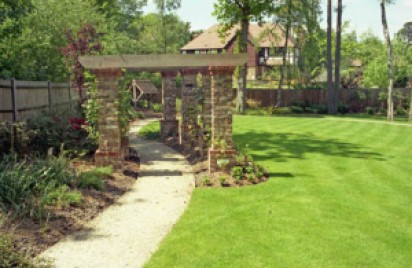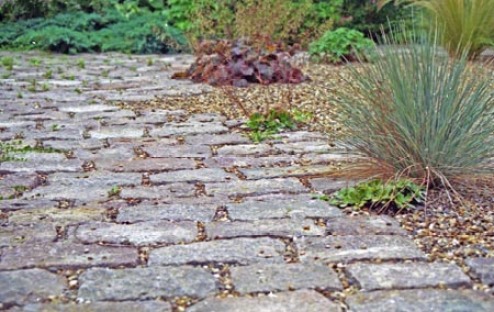Path
-
A winding garden path
A Winding Garden Path
 Pergola and Well features
Pergola and Well featuresWe added these lovely features to an executive’s garden that was designed and built a number of years ago.
They were part of a ‘Wish List’ we established with the client as we developed the masterplan.
Planning really is the secret to a successful outcome for your project too. So here are a few pointers to help you.
The Wish List.
The secret to a beautiful landscape project is the wish list – here is a typical one we have developed over the years.
Brief description of what you are looking for :
………………………………………………………………………
………………………………………………………………………
……………………………………………………………………….
………………………………………………………………………
………………………………………………………..How you use your garden :
Do you have animals ? : Yes / No.
Do children play in the garden ? : Yes / No.
Do you like gardening ? : Yes / No.
Do you like cutting grass ? : Yes / No
Do you entertain in the garden ? : Yes / No.
Do you like relaxing in the garden ?Yes/ No.
What sort of Budget you would like us to Design
to : ……………………………………………………
(It helps enormously if we can have a figure to
work to, we should be able to produce a Design
within 10 percent )Some items to consider :
Lawns. Yes / NoShrubberies Yes / No.
Rockeries Yes / No
Ponds Yes / No.
Streams Yes / No
Fish / Koi Ponds Yes / No.
Paths Yes / No
Patios Yes / No.
Terraces Yes / No.
Walls Yes / No.
Ground contouring Yes / No
Vegetable gardens Yes / No.
Garden Features :
Garden Shed : Yes / No.
Power & Lighting Yes / No.
Irrigation Yes / No.
Summerhouses Yes / No.
Greenhouses Yes / No
Gazebo’s Yes / No.
Pergolas Yes / No
Seating Yes / No.
Please add any other comments on the back of this sheet, the more we know the better the design.
I would recommend that this is something the homeowners complete themselves without a salesmen/designer being present. You would be amazed at how many couples have different ideas!
Remember to keep a little of the budget back as these things always cost more than you expect.
Once you have a wish list, start to gather examples of the features you like from magazines. Taking pictures etc. Pretty soon you will have a good idea of what you would ideally like.
Now it’s time to have that chat with the Designer or put pen to paper yourselves..
Views: 322
-
Paths in your Garden
Paths have been around awhile.
Granite sett path – these setts traveled from Portugal in the 1800’s as ships ballast and were then used on London’s streets.
They were a very convenient group of sizes namely ;-
- 4 inch x 4 inch x 4 inch
- 4 inch x 4 inch x 6 inch
- 4 inch x 4 inch x 8 inch
These regular sizes enable a module to be used, which makes the overall finished visual much more attractive. It’s also easier to lay – below you see a radius layout using just 4 inch x 4inch x 4inch setts.

Seeing as we have snow today, I thought it might be an idea to talk a little about paths and paving materials. Not all paving is equal as they say, concrete for instance is often more slippery than say asphalt ( there is a standard called CBR – California Bearing Ratio, this is basically a coefficient of slipperiness. Often only used for roadways and cars.)
So lets take a look at some paths

This gravel path works great, except when frost is just coming out of the surface, when it gets very sticky. Gravel paths are both attractive, economical and if laid on a suitable base long lasting, a simple rake and roll often restores the path to its near original state. Keeping on top of surface weed growth is essential.

Paths should be at least 5ft wide to allow a couple to walk side by side..although,in a garden this is often impractical.
This beautiful path leads all the way around the garden, making it a fabulous way to explore the differing views created.

This scented path uses camomile planted within the ‘p-shingle’.
We used old railway sleepers and camomile to create this pathway, the camomile grows and covers the widened joints. When you walk on the camomile a lovely scent rises up.

A more formal gravel path – this is a white limestone and approximately 4ft 6 inch wide – just wide enough for two people to stroll (promenade) around together
Here the path is dressed in graded white limestone, this creates a much more formal garden for the client.

The next is designed in a series of straight lines using a brick module.

Here a zig-zag brick path leads from one section of the garden to another Using stock bricks that compliment the house colours is a good way to ‘link’ a garden design to a house. Walking on a larger sized clean gravel, is both fun due to the noise and a safety feature as you can hear someone or something approaching.

Here we used a larger stone size to add that lovely crunching sound as you walk on the path 
Natural random rectangular stone leading to a bound gravel pathway.
Perhaps the most expensive form of path, the steps are laid in natural random rectangular stone, which is expensive to purchase and time consuming to lay..

Natural stone steps It was a hot day when they completed these steps….

Probably the best material for steps To finish with some of my favorite materials. I’ve always tried to use natural materials on projects as the colour does not fade with time, they are often long lasting – if laid correctly. They always look soft and blend in so well with the surroundings..but natural comes with a significant cost increase..
A quick word about patios, if you are using the patio for entertaining a normal table with four chairs requires an area of approximately 10ft 6 ins ( 3m) x 10ft 6 ins (3m) to accommodate the table and chairs.

Laying small unit sett paving of almost random size in a radiating pattern requires skill and patience…. Do send us a comment or a request
Views: 54



